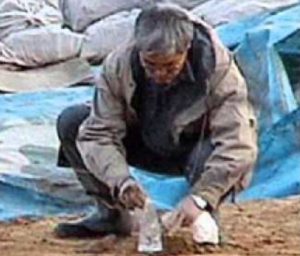Shinichi Fujimura was celebrated in Japan’s archeological circles – some even believed he had ‘divine hands’.
One of Fujimura’s first major discoveries was in 1981 when he found stoneware dating back 40,000 years, the oldest stoneware ever unearthed in Japan. By 1999 Fujimura had visited more than 150 dig sites and discovered artifacts at nearly all of them.
The Japanese government designated some of his dig locations as national historical sites. School children were taught about his important discoveries.
In 2000, when Fujimura was at the height of his fame, he was part of an ongoing excavation at a prehistoric site near Tsukidate, northeast of Tokyo. The celebrity archaeologist and the dig were major tourist attractions. Tsukidate even created a signature drink for the thirsty visitors called ‘Early Man’.
Stoneware unearthed at the Kamitakamori ruins in Tsukidate, purportedly dated back as far as 700,000 years, according to the Japan Times.
The incredible discoveries were drawing international attention. Questions were being raised, and they weren’t about Fujimura’s divine hands.
A small group of expert archaeologists examined Fujimura’s work in a research paper. They deemed his findings ‘odd’ in comparison to similar finds from the same era.
 Journalists from the Japanese newspaper Mainichi Shimbun decided to investigate. They planted hidden video cameras at one of Fujimura’s dig sites and discovered his secret: Fujimura was caught positioning 61 fake artifacts.
Journalists from the Japanese newspaper Mainichi Shimbun decided to investigate. They planted hidden video cameras at one of Fujimura’s dig sites and discovered his secret: Fujimura was caught positioning 61 fake artifacts.
Mainichi Shimbun‘s exposé revealed that Fujimura would take artifacts either from his own collection or other sites, bury them at the site in the morning, then dig them up again later and claim to have made extraordinary discoveries.
When presented with the evidence, Fujimura confessed. Of 31 pieces ‘found’ at the Kamitakamori site, he admitted to having faked 27.
Fujimura claimed in a tearful admission that he had been possessed by an uncontrollable urge, but insisted that most of his other findings were legitimate.
“I was tempted by the Devil. I don’t know how I can apologize for what I did… I wanted to be known as the person who excavated the oldest stoneware in Japan,” he explained.
The Japanese Archaeological Association expelled Fujimura and then spent nearly three years reviewing the scandal, finally admitting in 2003 that they could have done more to uncover the vast inconsistencies in his fraudulent artifacts. School books were rewritten. The Tokyo National Museum removed more than a dozen artifacts from display; others followed suit. Japanese archaeologists were pushed to review findings of the country’s Palaeolithic period.
The chairman of the Japanese Archaeological Association, Ken Amaksu, admitted Japan’s academic environment may have played a role in the scandal.
“We need to examine… whether enough information was disclosed and enough theories were exchanged among researchers with differing opinions concerning the new discoveries,” Amaksu said.




